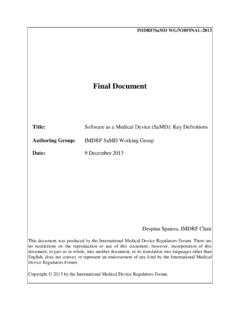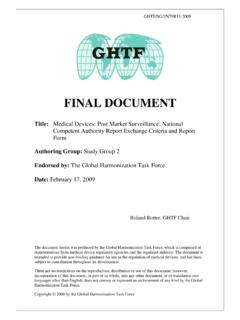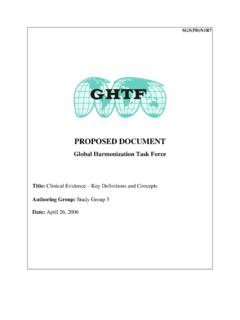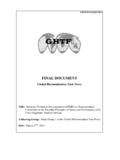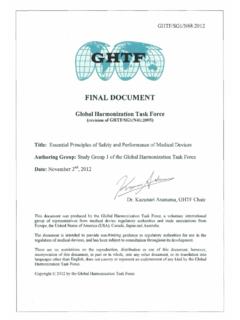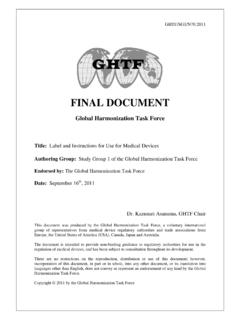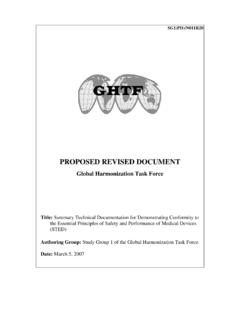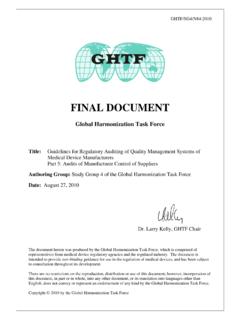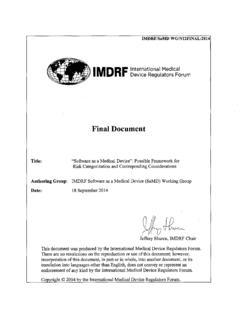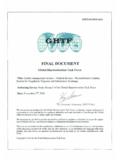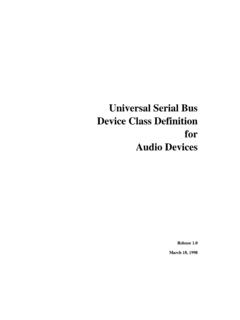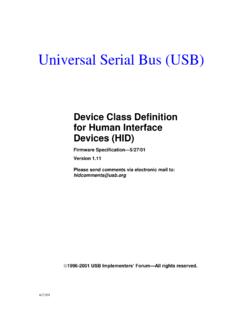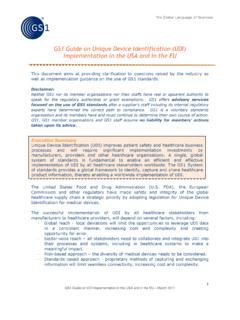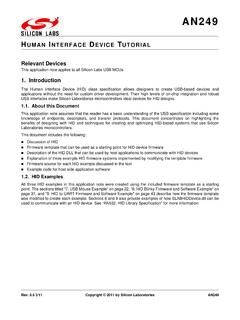Transcription of GHTF SG1 Principles of Medical Devices Classification ...
1 Principles of Medical Devices Classification Study Group 1 Final Document GHTF/SG1/N77:2012 November 2nd , 2012 Page 2 of 30 Table of Contents Introduction .. Rationale, Purpose and Scope .. Rationale .. Purpose .. Scope .. References .. Definitions .. General Principles .. Classification System for Medical Devices .. Structure of the Classification Rules .. Diagrammatic Representation of the Classification System .. Manufacturer s Determination of Device Class .. Classification Rules .. Non-Invasive Devices .. Invasive Devices .. Active Devices .. Additional Rules .. Rationale for the inclusion of the Additional Rules within this document.
2 Reclassification of Medical Devices .. 23 Appendix A: Decision trees to illustrate how the rules may be used to classify specific Devices .. 24 Principles of Medical Devices Classification Study Group 1 Final Document GHTF/SG1/N77:2012 November 2nd , 2012 Page 3 of 30 Preface The document herein was produced by the Global Harmonization Task Force, a voluntary group of representatives from Medical device Regulatory Authorities and the regulated industry. The document is intended to provide non-binding guidance for use in the regulation of Medical Devices , and has been subject to consultation throughout its development. There are no restrictions on the reproduction, distribution, translation or use of this document.
3 However, incorporation of this document, in part or in whole, into any other document does not convey or represent an endorsement of any kind by the Global Harmonization Task Force. Principles of Medical Devices Classification Study Group 1 Final Document GHTF/SG1/N77:2012 November 2nd , 2012 Page 4 of 30 Introduction The primary way in which the GHTF achieves its goals is through the production of a series of guidance documents that together describe a global regulatory model for Medical Devices . The purpose of such guidance is to harmonize the documentation and procedures that are used to assess whether a Medical device conforms to the regulations that apply in each jurisdiction.
4 Eliminating differences between jurisdictions decreases the cost of gaining regulatory compliance and allows patients earlier access to new technologies and treatments. This document has been developed to encourage and support global convergence of regulatory systems. It is intended for use by Regulatory Authorities (RAs), Conformity Assessment Bodies (CABs) and industry, and will provide benefits in establishing, in a consistent way, an economic and effective approach to the control of Medical Devices in the interest of public health. It seeks to strike a balance between the responsibilities of R As to safeguard the health of their citizens and their obligations to avoid placing unnecessary burdens upon the regulated industry.
5 This document should be read in conjunction with the GHTF document entitled Principles of Conformity Assessment for Medical Devices that prescribes conformity assessment requirements appropriate to each of the four classes proposed herein. The link between device Classification and conformity assessment is fundamental to the development of an effective global regulatory model. If such is adopted in a consistent manner by all jurisdictions, the goal of a premarket approval for a particular device being accepted globally, may be achieved. This document supersedes GHTF/SG1/N15:2006 which provided guidance on the same topic.
6 It has been modified to: clarify the basis of allocating Medical Devices to one of four classes; change the rule applying to sterilisation and disinfection Devices ; remove the inconsistency with GHTF/SG1/N011 Summary Technical Documentation for Demonstrating Conformity to the Essential Principles of Safety and Performance of Medical Devices (STED); add a Section on the reclassification of Medical Devices ; and incorporate changes resulting from the public scrutiny process. Where other guidance documents within the series are referenced within this text, their titles are italicised for clarity. Study Group 1 of the Global Harmonization Task Force (GHTF) has prepared this guidance document.
7 Comments or questions about it should be directed to either the Chair or Secretary of GHTF Study Group 1 whose contact details may be found on the GHTF website1 . 1 Principles of Medical Devices Classification Study Group 1 Final Document GHTF/SG1/N77:2012 November 2nd , 2012 Page 5 of 30 Rationale, Purpose and Scope Rationale It is widely accepted that there should be a method to separate Medical Devices into a small number of groups, or classes, and subsequently apply different conformity assessment techniques to each class. The global adoption of a rules-based Classification procedure would offer significant benefits to manufacturers, users, patients, and RAs and support global convergence of regulatory systems.
8 Purpose To stipulate a series of Principles and rules that allow a Medical device to be assigned to one of four classes based on its intended use, and thereby: assist a manufacturer to allocate its Medical device to an appropriate class using a set of Classification rules; and allow RAs to pronounce upon matters of interpretation for a particular Medical device, when required so to do. Subsequently, such Classification will determine the conformity assessment procedures that will be applied to the device. This document is intended for use by RAs, CABs and the regulated Industry, Scope This document applies to all products that fall within the definition of the term Medical device , other than IVD Medical Devices , for which a separate Classification document is available on the GHTF website.
9 References2 GHTF/SG1/N44:2008 Role of Standards in the Assessment of Medical Devices . GHTF/SG1/N68:2012 Essential Principles of Safety and Performance of Medical Devices . GHTF/SG1/N70:2011 Label and Instructions for Use for Medical Devices . GHTF/SG1/N071:2012 definition of the Terms Medical Device and In Vitro Diagnostic (IVD) Medical Device . GHTF/SG1/N78:2012 Principles of Conformity Assessment for Medical Devices . 2 The listed documents are subject to periodic review and may be superseded by later versions. The reader is encouraged to refer to the GHTF website to confirm whether the referenced documents remain current.
10 Principles of Medical Devices Classification Study Group 1 Final Document GHTF/SG1/N77:2012 November 2nd , 2012 Page 6 of 30 Definitions Accessory to a Medical device: Means an article intended specifically by its manufacturer to be used together a particular Medical device to enable or assist that device to be used in accordance with its intended use. Active Medical device: Any Medical device, operation of which depends on a source of electrical energy or any source of power other than that directly generated by the human body or gravity and which acts by converting this energy. Medical Devices intended to transmit energy, substances or other elements between an active Medical device and the patient, without any significant change, are not considered to be active Medical Devices .
